
Hyper-automation combines multiple aspects of automated processes, tools, and technology to increase the potential to automate operations. Artificial intelligence (AI), machine learning, robotic process automation (RPA), and other types of decision, process, and task automation tools are all examples of hyper-automation.
Organizations can use hyper-automation to embed digital technology into their operations and legal systems. By adopting hyper-automation & tools such as robotic process automation in their business operations, organizations can access data and collaborate effectively, boost employee capacities, minimize operating expenses and errors, and increase productivity by reducing manual tasks. The amalgamation and integration of these technology tools play a vital role in hyper-automation.
Hyper-automation brings together the two main components of any organization – labor, and workflow – and improves operational efficiency and, as a result, the bottom line. Expertly merging the capabilities of machine learning and robotic process automation, hyper-automation takes process automation to the next level. Not only will it automate human actions but also human decision making.
Cutting-Edge Tools and Technology Enabling Hyper-Automation

- Artificial intelligence (AI) and machine learning
Artificial intelligence (AI) is critical for achieving degrees of automation that humans could never accomplish. Hyper-automation builds on AI by further broadening the goals and capabilities of automation. This leads to more accurate, faster, and efficient results. Machine learning algorithms have been in constant development and are ideal for document processing software that streamlines the process. Machine learning has allowed organizations to deploy their data to new uses. They can unearth useful insights rather than gazing at a mass of unrelated data fragments. When used in confluence with robotic process automation, AI becomes a potent tool for hyper-automation.
- Optical character recognition (OCR)
Optical character recognition (OCR) enables high accuracy retrieval and unification of data from the most complicated documents. Its additional features include deploying character recognition tools to analyze pixels in an image and determine a proper character. Although OCR technology can be used to scan and digitize documents, it has limitations. Many OCR engines are unable to support and comprehend the complexities of a document’s input data. However, when layered with AI and machine learning technologies, OCRs are further equipped with intelligent document processes (IDP) which help to analyze, classify, and extract information from any written document.
- Robotic process automation (RPA)
Robotic process automation (RPA) allows users to leverage software robots, or “bots,” that can understand, replicate, and then execute business operations based on the rules that enable a user to set up one or more scripts to perform particular keystrokes. RPA software robots can engage with any application interface in the same manner that humans can, with the exception that RPA bots can work around the clock, uninterrupted, considerably faster, and with 100% precision and accuracy.
Bots can copy-paste, harvest web data, perform calculations, access, and transfer files, analyze emails, log into programs, link to APIs, and retrieve complex data, to name a few capabilities. Thus, robotic process automation adds value to every organization by automating document and process management.
- Process mining
Before an organization automates its business workflow, process mining is critical for gaining knowledge and understanding of business processes, as well as laying the framework for smart functional flexibility. Process mining allows existing workflow and processes to change in response to changing business conditions. It is critical to the effective adoption of hyper-automation as it gives an end-to-end view of the business operations and provides a critical understanding of the problem areas prior to automation.
Process mining allows the organization to zero down on specific sections of the process and explains why anomalies occur. Instead of functioning under assumptions, organizations can use process mining to expose what’s really going on in their processes. They can then pinpoint the source of obstacles in real time, optimize their assets, and expand with certainty and proficiency. Robotic process automation buttresses process mining, by enabling businesses to automate processes and smooth over points of friction.
- Natural language processing (NLP)
Natural language processing can retrieve and organize data from documents, such as determining whose organization an invoice is from and what it’s about, and automatically capturing this material into the accounting system. To begin, text analytics (typically low-level) methods are employed to break down sentences into distinct elements, such as named entity recognition, text classification, and sentiment analysis. These elements are then deciphered using NLP, which analyses the text and further categorizes the message being conveyed. This can then be leveraged by organizations for intelligent document comprehension and analysis.
Organizations are expected to fully adopt hyper-automation and integrate digital technology into their existing business ecosystems by 2024 and reduce operational costs by 30%. Through hyper-automation, coupled with crucial tools like robotic process automation, organizations can ensure their expansion in response to new needs and requirements. Using intelligent technology-based tools, organizations can fully adapt to rapidly changing market dynamics and incorporate human functions only where necessary. 5 Hyper Automation Technologies in Document Management – SignDesk